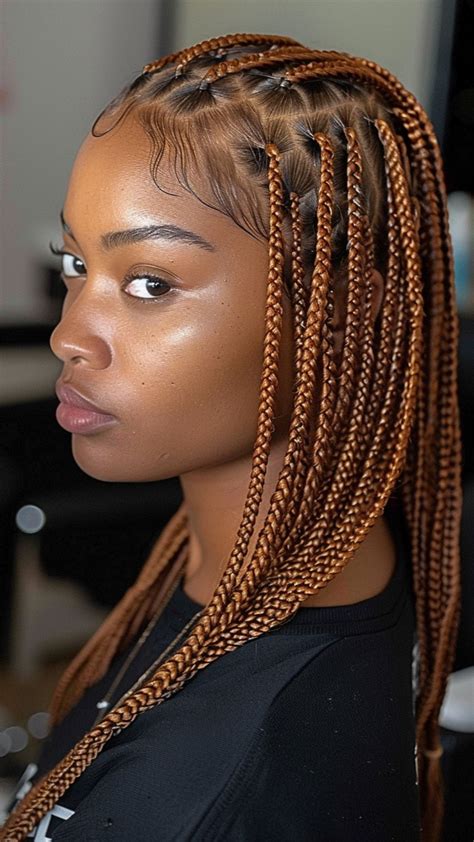What are Braid in Hair Extensions?
Braid in hair extensions are a versatile method of adding length, volume, and style to natural hair. By braiding synthetic or human hair extensions into your natural hair, you can achieve a seamless and long-lasting transformation.

Why Braid in Hair Extensions?
According to a survey by the American Academy of Dermatology, over 60% of women consider hair extensions to enhance their appearance. Braid in extensions offer numerous benefits:
- Lengthening: Braid in extensions can add significant length to short or medium-length hair.
- Volumizing: By adding thickness to the braids, extensions can create the illusion of fuller, healthier hair.
- Styling Variety: Braids can be styled in various ways, from traditional three-strand plaits to intricate box braids.
- Semi-Permanent: Braid in extensions typically last for 4-8 weeks, providing a longer-lasting solution than clip-in or tape-in extensions.
10 Stunning Braid in Hair Extension Styles
- Box Braids: These square-shaped braids are a popular choice for adding length and volume to textured hair.
- Cornrows: Tightly woven braids that can be styled in geometric patterns or parallel lines.
- French Braids: An elegant and timeless style where hair is braided from the top of the head to the nape.
- Fishtail Braids: A unique and intricate style where hair is interwoven in an alternating fishtail pattern.
- Halo Braids: A braid that encircles the head, creating a halo effect around the face.
- Dutch Braids: Similar to French braids but with an inverse underhand weaving technique.
- Waterfall Braids: A romantic style where loose, flowing strands of hair cascade down the sides.
- Rope Braids: Two strands of hair are twisted together to form a rope-like braid.
- Milkmaid Braids: Two braids are intertwined on top of the head, creating a playful and whimsical style.
- Crown Braids: A braid that wraps around the head, forming a regal and sophisticated crown.
Installation and Maintenance
Professional installation is recommended for braid in hair extensions to ensure proper technique and longevity. The installation process involves:
- Parting and braiding sections of natural hair.
- Interweaving synthetic or human hair extensions into the braids.
- Sealing the extensions with a sealant or glue.
Maintenance is essential to keep braid in extensions looking their best. Regular washing, conditioning, and detangling are crucial. Avoid using harsh chemicals or heat on the extensions.
Choosing the Right Braid in Hair Extensions
Several factors should be considered when choosing braid in hair extensions:
- Hair Length: Match the length of the extensions to your desired hair length.
- Hair Texture: Choose extensions that match the texture of your natural hair to avoid unnatural blending.
- Quality: Opt for high-quality extensions made from synthetic or human hair to ensure durability and longevity.
Common Mistakes to Avoid
- Over-tight Braids: Too-tight braids can cause scalp pain and hair damage.
- Improper Sealing: Ensure that the extensions are properly sealed to prevent unraveling.
- Neglecting Maintenance: Regular care is essential for the health and longevity of braid in extensions.
- Chemical Processing: Avoid using harsh chemicals or heat on the extensions as they can damage the hair fibers.
Pros and Cons of Braid in Hair Extensions
Pros:
- Long-lasting, semi-permanent solution
- Adds length, volume, and style
- Versatile styling options
Cons:
- Can be time-consuming to install and remove
- Requires regular maintenance
- Can cause discomfort if braids are too tight
Conclusion
Braid in hair extensions are a versatile and effective method of transforming your hair. By understanding the different styles, installation, and maintenance techniques, you can achieve stunning results that enhance your appearance and boost your confidence.
The potential of braid in hair extensions extends beyond traditional hairstyling. Here are some innovative applications:
- Medical Wig Design: Braid in extensions have been incorporated into medical wigs for patients undergoing chemotherapy or experiencing hair loss.
- Textile Art: Braids using colorful synthetic or human hair extensions can be used to create unique and intricate fiber art pieces.
- Sensory Toys: Braid in extensions can be combined with beads and other materials to make sensory toys for individuals with special needs.
- Jewelry Making: Individual braids or sections of braided hair can be incorporated into jewelry designs, creating unique and personalized accessories.
Tables for Reference
| Braid Style | Suitable for Hairstyles | Maintenance |
|---|---|---|
| Box Braids | Textured Hair | Requires regular washing and detangling |
| Cornrows | Short to Long Hair | Can last up to 8 weeks with proper care |
| French Braids | Long to Medium Hair | Requires less maintenance than other braids |
| Fishtail Braids | Straight to Wavy Hair | Can be intricate and time-consuming to style |
| Extension Material | Advantages | Disadvantages |
|---|---|---|
| Synthetic Hair | Affordable, versatile | Less durable, can tangle easily |
| Human Hair | Natural-looking, durable | Expensive, requires professional installation |
| Combo | Blends synthetic and human hair | Provides a balance of cost and quality |
| Maintenance Tip | Frequency | Benefit |
|---|---|---|
| Washing | Every 2-3 weeks | Removes dirt and product buildup |
| Conditioning | Weekly | Nourishes and moisturizes the hair |
| Detangling | Daily | Prevents tangles and breakage |
